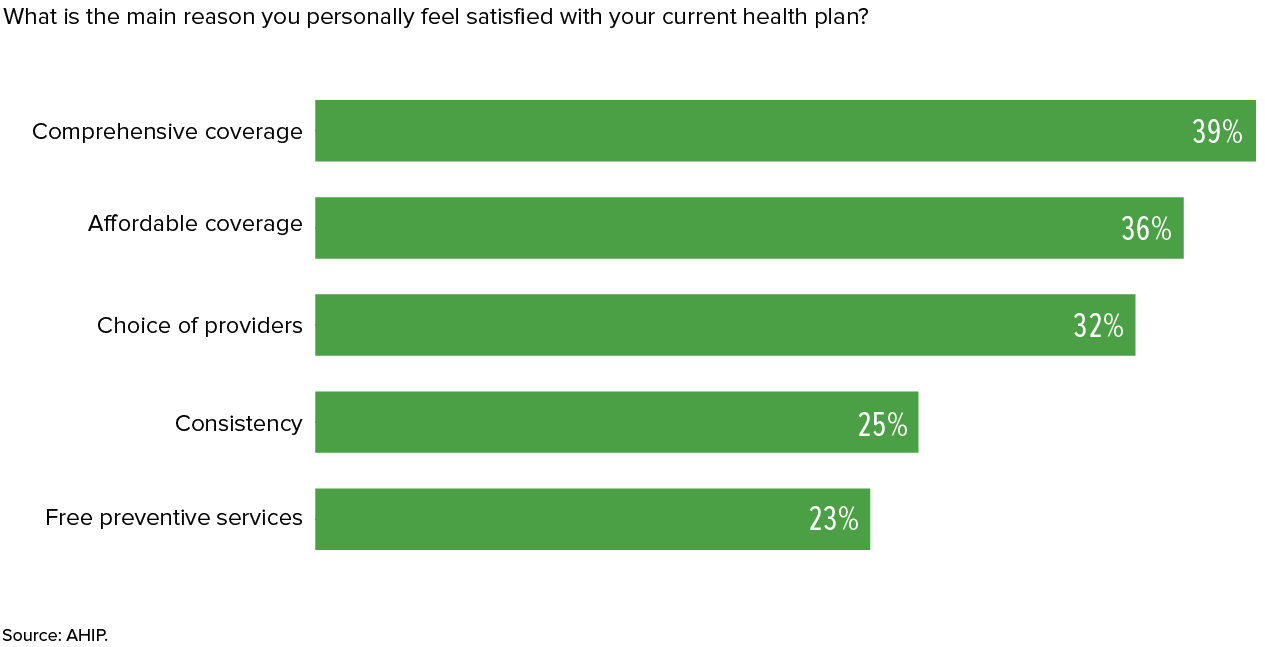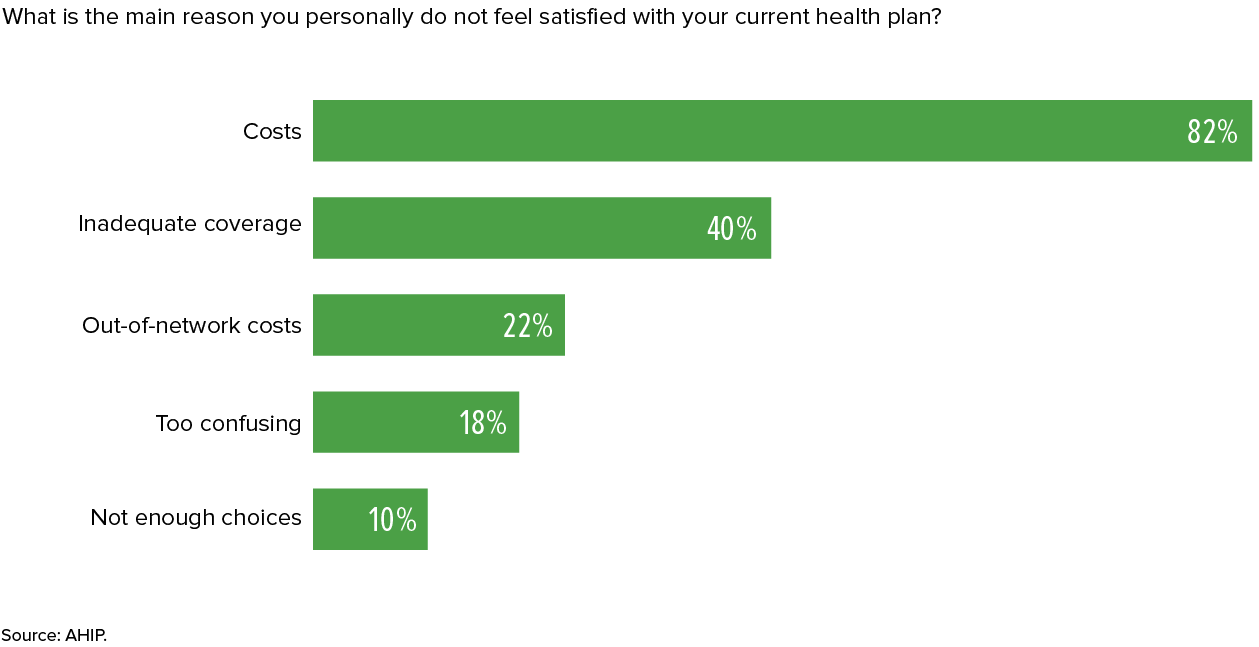Employees Are More Likely to Stay If They Like Their Health Plan
But employer-sponsored health coverage needs to be more flexible to innovate and meet workers' health care needs, experts say

Employer-provided health coverage is important for recruiting, but even more important for retention.
A new survey shows that:
- 56 percent of U.S. adults with employer-sponsored health benefits said that whether or not they like their health coverage is a key factor in deciding to stay at their current job.
- 46 percent said health insurance was either the deciding factor or a positive influence in choosing their current job.
"We were surprised to see such a large percentage of American workers who indicated the importance of health coverage in choosing and staying at their job," said Phillip Morris, vice president of Luntz Global Partners, which conducted the survey for America's Health Insurance Plans (AHIP), a trade association for health insurers.
The survey findings showed that 71 percent of employees are satisfied with their current employer-provided coverage but that high costs worry many.
Responses were gathered Jan. 25-28 from 1,000 U.S. adults receiving health care through their workplace. The results were released at a Feb. 6 expert panel event in Washington, D.C., sponsored by AHIP and the nonprofit Bipartisan Policy Center.
Satisfaction Driven by Coverage, Cost and Choice

But:
Costs Are Top Dissatisfaction Driver
Among other findings:
- Most workers (71 percent) remain concerned that the cost of their health plans will continue to rise.
- The benefits they said matter most to them were prescription drug coverage (cited by 51 percent of respondents), preventive care (47 percent) and emergency care (47 percent).
Fostering Innovation
"Employer-provided insurance is the cornerstone of the U.S. health care system, covering over 150 million Americans and spurring innovation that helps improve the overall health care marketplace," said David Cordani, president and CEO of Cigna, who spoke at the AHIP/Bipartisan Policy Center event. "Employer-provided coverage helps employers create localized communities of health to help their employees stay healthy and productive, while pursuing targeted innovation that works for their unique needs."
"Large employers are pushing the envelope by improving access to high-quality care and driving employee engagement with their health benefits," said Brian Marcotte, president and CEO of the nonprofit National Business Group on Health, an employers group, during a panel discussion.
He noted recent success in the growth of telehealth and virtual health coaching services, which have changed how chronic disease is being managed.
"Five years ago, 14 percent of large companies offered telehealth services to their employees," Marcotte said. "Today, 96 percent of large companies offer telehealth." In addition, over half now offer tele-behavioral health consultations for mental health issues, "which is a 50 percent increase over last year."
Listening to Employees
"You have to know your employees and what they want" from their health benefits, advised Paula Harvey, SHRM-SCP, vice president for human resources at Schulte Building Systems, a 600-employee metal-building fabrication company in Hockley, Texas. "Don't just sit in your office looking at claims numbers. Get out and talk to your employees, find out what's working for them."
Harvey, who represented the Society for Human Resource Management on the panel discussion, is a SHRM Foundation board member and served on SHRM's membership advisory council for the Southeast.
"Find innovative ways to get the conversation [about health] going," Harvey said. "My employees can participate in wellness challenges with themselves" and track their progress online. "We provide walking trails" to encourage employees to get out and move during lunch or before and after work.
"It's hard for employees to take time away from work to use their health benefits," she noted. "We all have sick days we can use, but if we're thinking about increasing vaccination rates or primary care visits, why don't we offer individuals 'healthy days' so they can access preventative care services," giving workers the flexibility to use their benefits.
Bringing management onboard for health-promoting initiatives at her firm wasn't a hard sell, Harvey noted. "CEOs care about their employees being healthy, because healthy employees show up to work."
[SHRM members-only toolkit: Managing Health Care Costs]
Applying Value-Based Designs
Value-based design (VBD) that "spends more on the things that make people healthier and less on the things that don't" is increasingly part of health plans that employers self-fund, but laws and regulations have hindered its wider use, said Mark Fendrick, M.D., director of the University of Michigan Center for Value-Based Design.
He favors insurance that pays a greater share of the cost for services "when the evidence of effectiveness is strong"—such as those noted by clinician organizations participating in the Choosing Wisely initiative—"and raises the cost for services where the evidence of effectiveness is weak."
"We need to incorporate VBD into health savings accounts, which I love, but which are tied to high-deductible health plans, which are not nuanced or flexible," Fendrick said. He urged changing government policies to give HDHPs the flexibility to cover high-value services outside of the deductible so that "people don't have to hold a bake sale to access services they need."
He described wrenching e-mails he receives from employees that say, "Thank you for the no-cost mammogram, but I can't afford the deductible for my mastectomy," or "Thank you for the Hepatitis-C screening, but I don't have access to the therapy."
He added, "Sadly, many patients diagnosed with HIV through a free screening find it really difficult to afford potentially life-saving therapies."
Looking forward, "We can make HDHPs into high-value plans," Fendrick said. "We need to overcome government policy inertia to make this happen."
The recently introduced Chronic Disease Management Act of 2018, for instance, would amend the IRS tax code so that high-deductible health plans paired with HSAs could cover chronic disease prevention and treatment on a pre-deductible basis.
Related SHRM Article:
High-Deductible Plans More Common, but So Are Choices, SHRM Online Benefits, February 2018
Was this article useful? SHRM offers thousands of tools, templates and other exclusive member benefits, including compliance updates, sample policies, HR expert advice, education discounts, a growing online member community and much more. Join/Renew Now and let SHRM help you work smarter.
An organization run by AI is not a futuristic concept. Such technology is already a part of many workplaces and will continue to shape the labor market and HR. Here's how employers and employees can successfully manage generative AI and other AI-powered systems.



